Molten metal meets modern methods
3D printing preps LU sculpture students for opportunities
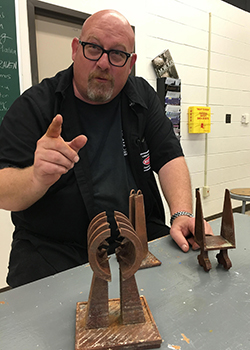 “We’re doing great things using this new technology in creating sculpture,” said Lamar University’s Kurt Dyrhaug, professor of studio art and sculpture whose genre ranges from industrial-scale installations of wood and iron to diminutive designs that blend the latest technology, traditional and trend-setting techniques.
“We’re doing great things using this new technology in creating sculpture,” said Lamar University’s Kurt Dyrhaug, professor of studio art and sculpture whose genre ranges from industrial-scale installations of wood and iron to diminutive designs that blend the latest technology, traditional and trend-setting techniques.
“The students are so excited about the technology,” he said. “They can’t get enough of it.”
Originally of St. Paul, Minnesota, his art centers on themes of agricultural and nautical imagery drawn from his experiences living in Southeast Texas. Evident in his work, too, are the mechanical forms and elements of industry, presenting iconic images with new associations and meanings. His research focuses on cast metal sculpture and uses 3D printing technology for mold making in the foundry.
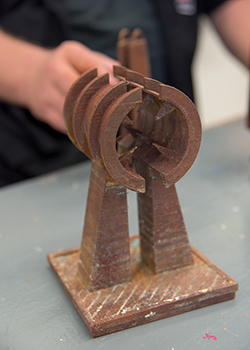 The 3D sculptures can either be used in the “lost wax” technique where molten metal burns away the material as it is poured into a mold, or they can be painted with various metal coatings. For the class, Dyrhaug uses a so-called “green plastic” known as PLA (poly lactic acid) a biodegradable material made from plant-based resources such as cornstarch or sugar cane. The material melts at around 400 degrees Fahrenheit and so can be used to in the “lost wax” method of metal casting where the molten metal rapidly burns away the sacrificial form in a mold.
The 3D sculptures can either be used in the “lost wax” technique where molten metal burns away the material as it is poured into a mold, or they can be painted with various metal coatings. For the class, Dyrhaug uses a so-called “green plastic” known as PLA (poly lactic acid) a biodegradable material made from plant-based resources such as cornstarch or sugar cane. The material melts at around 400 degrees Fahrenheit and so can be used to in the “lost wax” method of metal casting where the molten metal rapidly burns away the sacrificial form in a mold.
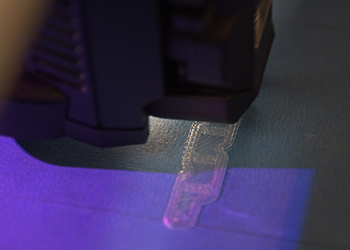 His students use 3D software to create designs, which they then print on one of eight 3D printers in the art department. After printing, they refine their work by removing the supporting elements that are part of the printing process, sand areas as needed, and fill any voids with wax.
His students use 3D software to create designs, which they then print on one of eight 3D printers in the art department. After printing, they refine their work by removing the supporting elements that are part of the printing process, sand areas as needed, and fill any voids with wax.
“These 3D prints aren’t perfect,” Dyrhaug said. “There’s always a lot of clean up to do and there are tricks to getting it ready for coating or casting.”
Dyrhaug is continuing exploration into metal coatings in his own art. “Using 3D printing, now I don’t even have to cast my pieces. They can be metalized with a product that I can paint or spray on, in bronze, iron, pewter or copper.”
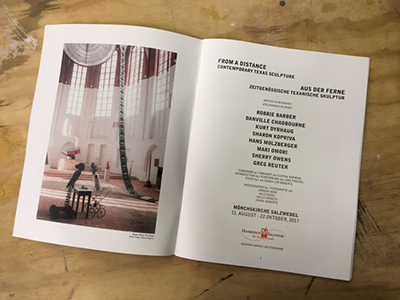 Recently he created three pieces to complete at an artist residency in Corme, Spain. Because he was flying, he couldn’t take the solutions he’d been using to create the desired patina and instead had to find them locally. When he wasn’t able to find what he’d been using, he improvised with commonly available materials, but wasn’t getting the results he wanted. He reached out to fellow LU faculty member Richard Lumpkin, associate professor of inorganic chemistry, who recommended warming the solution to increase the reaction.
Recently he created three pieces to complete at an artist residency in Corme, Spain. Because he was flying, he couldn’t take the solutions he’d been using to create the desired patina and instead had to find them locally. When he wasn’t able to find what he’d been using, he improvised with commonly available materials, but wasn’t getting the results he wanted. He reached out to fellow LU faculty member Richard Lumpkin, associate professor of inorganic chemistry, who recommended warming the solution to increase the reaction.
“Now I’ve found something a lot less toxic and much less expensive that yields very similar results,” Dyrhaug said. In addition to aging the metals, he also uses acrylic paints, and other techniques to grant new objects an ageless patina.
Many students are coming into the course with some exposure to 3D printing, or at least have a general idea of the process, Dyrhaug said.
Students have come up with a wide array of projects, he said. One graphic design student who has multiple sclerosis is using 3D printing to create examples of human anatomy such as the brain and spine to illustrate the significance of the disease.
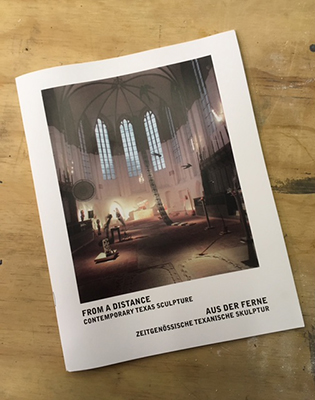 “Some students make art, one made a line of basketball shoes, another redesigned the Nintendo game controller,” Dyrhaug said. “I let them find what they want to do and they come at it with many different approaches.”
“Some students make art, one made a line of basketball shoes, another redesigned the Nintendo game controller,” Dyrhaug said. “I let them find what they want to do and they come at it with many different approaches.”
In addition to the printers, the department has a basic 3D scanner where students can scan an object and bring the data into software that they then can manipulate or modify.
“Our students are learning 3D printing for studio art, or potential jobs in a variety of fields,” Dyrhaug said. “Soon they might be running a 3D printer at a company, whether an ad agency or a technology firm. They’re getting the knowledge to get in the door creating art, new products, or building prototypes.”
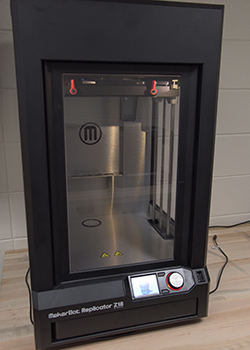 The machines, range in price from $2,500 to $7,500, and while not cheap, are on the lower end of the 3D printing spectrum. Fortunately, the materials used aren’t too expensive, but at around $2 an ounce closely examining the digital files before printing is always advised, Dyrhaug said.
The machines, range in price from $2,500 to $7,500, and while not cheap, are on the lower end of the 3D printing spectrum. Fortunately, the materials used aren’t too expensive, but at around $2 an ounce closely examining the digital files before printing is always advised, Dyrhaug said.
Dyrhaug and 3D technician Billie Rose Smith keep the eight machines operating smoothly, and because 3D printing takes considerable time, work to keep scheduling conflicts to a minimum.
The new technology is taking wing as its potentials are explored. It has given Dyrhaug wings as well — using 3D printing in his art has enabled him to participate in studies abroad.
Dyrhaug’s art has taken him to Tokyo, Germany and Spain. His international experiences began with an invitation to Tokyo. “That was incredible,” he said. “Once you go overseas, you’re hooked.”
In 2015, he was an invited consultant to build a cast iron furnace and coordinate a community iron pour at the Atelierhaus Hilmsen Residency in Hilmsen, Germany.
He’s keen on providing opportunities for LU students to also expand their horizons, so when he returned to Hilmsen the following summer, he came with four LU students as part of a global studies course. There, the students focused on 3D printing and, using the lost wax process, cast their art in iron.
“I’d like to create more opportunities for students to go abroad in the future,” he said.
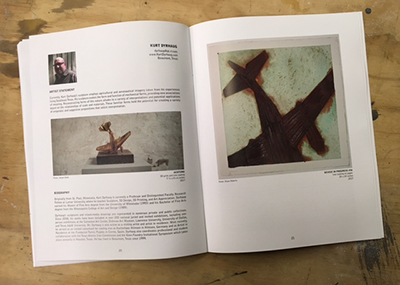 In April 2017, Dyrhaug was artist in residence at the Museo de Arte Contemporano Costa da Morte in Corme, Spain, where he researched iron coating and acrylic paint on 3D prints and paper. His completed sculpture and drawing is in the museum’s permanent collection.
In April 2017, Dyrhaug was artist in residence at the Museo de Arte Contemporano Costa da Morte in Corme, Spain, where he researched iron coating and acrylic paint on 3D prints and paper. His completed sculpture and drawing is in the museum’s permanent collection.
He returned to Hilmsen, Germany, in May 2017 as an artist in residence to continue his research on iron coating on paper. He again traveled to Hilmsen in July and August where he completed 3d prints, drawing, and wood sculpture for a group exhibition, "From a Distance: Contemporary Texas Sculpture" at the Mönchskirche Museum, Salzwedel, Germany. While there he also coordinated a mold making and ceramic shell workshop with Luke Sides, professor of sculpture at Collin College in Plano.
Next summer, he will coordinate an International Symposium on 3D Printing and Cast Metal in Hilmsen, Germany with Professor Sides and Hans Molzberger, professor of sculpture at Houston Baptist University.
LU’s Department of Art purchased its first 3D printer, a Makerbot Z18, in January 2016. That May, a technology grant from LU’s Center for Innovation, Commercialization and Entrepreneurship allowed the department to upgrade its 3D software, and purchase two additional 3D printers and printing supplies. Soon, 3D printing became a part of the first art class at LU, and, that fall, curriculum was rewritten to incorporate 3D modeling and animation. More printers were purchased as demand for the technology grew. Soon, students were scanning and printing objects and using the lost wax technique to cast forms in aluminum. Two students used 3D printing as a major component of their graphic design and sculpture theses.
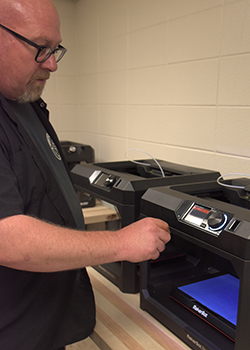 Early this year, Dyrhaug attended a 3D printing course at Makerbot Headquarters in Brooklyn, New York, and the department added two more printers, as Dyrhaug continued implementation of 3D printing and scanning in his sculpture classes. His work is being noted in the field as his 3D printing process and sculptures were spotlighted in newest edition of "Gateways to Art" textbook.
Early this year, Dyrhaug attended a 3D printing course at Makerbot Headquarters in Brooklyn, New York, and the department added two more printers, as Dyrhaug continued implementation of 3D printing and scanning in his sculpture classes. His work is being noted in the field as his 3D printing process and sculptures were spotlighted in newest edition of "Gateways to Art" textbook.
“I am excited about the developments in the department of Art and that we are giving opportunities to our students to go wherever the technology will take them,” Dyrhaug said. “It’s been an exciting ride.”


